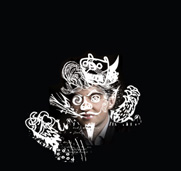[ORIGINALLY PUBLISHED IN THE NEW REPUBLIC, JANUARY 5, 2005.]
HENRY DARGER WAS A TALENTED BUT TROUBLED MAN.
Storm of Creativity
by Nathaniel Rich
Much of what we know about the life of the reclusive writer
and artist Henry Darger comes from his memoir, The History
of My Life, which at just over 5,000 pages was one of
the shortest things he ever wrote. The first 200 pages relate
the story of his troubled childhood. Born in 1892 on Chicago's
north side, he loses both of his parents at an early age, and
a sister, whom he never meets, is given up for adoption. At
the age of twelve, due to his unruly behavior (many believe
that he was caught masturbating at Catholic school), he is
sent to the Illinois Asylum for Feeble-Minded Children, an
institution which later attained local notoriety for its staff's
abusive treatment of its patients, in a town over 100 miles
south of Chicago. At age 17, Darger escapes the asylum and
sets out for Chicago--by foot. He is on this trek home when,
on page 206, he observes "a most singular and unbelievable
phenomenon," his account of which tells us more about
his personality and his art than any autobiographical detail
ever could. The "phenomenon" that Darger sees is
a giant tornado tearing across the plains. He does not try
to contain his excitement:
It had far more wallop than even a powerful atomic bomb. However
stupendous and shocking the many different catastrophes of
the past may be, none of them can compare to this storm. It
was a wind convulsion of nature tremendous beyond all man's
conception, immeasurable beyond all man's conception, immeasurable
beyond measure.
His description of this tornado, and the destruction it wreaks
across southern Illinois, occupies the rest of his memoir--all
4,878 pages of it.
Although he never explicitly mentions it in the pages of his
memoir, a different kind of storm did overtake Darger at this
time in his life, a torrent of creativity that was itself a
most singular and unbelievable phenomenon. Upon returning to
Chicago after his cross-state trek he began work on The
Story of the Vivian Girls, In What is Known as the Realms of
the Unreal, of the Glandeco-Angelinian War Storm, as caused
by the Child Slave Rebellion. At 15,000 pages, it is by
far the longest novel ever written. Over the next 65 years
Darger would write, in addition to the Realms, an
8,000 page sequel, his memoir, and a number of journals and
weather logs--over 30,000 pages in all, most of them typed
single-spaced on oversized paper with small margins and few
line breaks.
He also produced hundreds of haunting, darkly majestic paintings
on scrolls as long as ten feet that illustrate scenes from
the Realms. Darger did all of this in total secrecy
and solitude while living in a succession of cheap one-room
apartments. His neighbors knew him only as a prickly, penniless
man who worked janitorial jobs and attended Church several
times a day. Otherwise he rarely left his room. When he did,
he would often be spotted talking to himself or picking through
garbage cans. Whenever a neighbor or landlord tried to engage
him in conversation he would not reply directly to their questions
but only offer disconnected comments about the weather--particularly
about storms and tornados that were headed, he warned, toward
Chicago.
After Darger's death in 1973, his landlord
of 40 years, a photographer and artist named Nathan Lerner,
discovered the paintings and manuscripts while clearing out
his room. In the decades since, and especially in recent years,
the artwork has made Darger an international celebrity. His
paintings have toured museums around the world, usually under
the designation of "outsider art" (art made by unschooled
and often mentally disturbed artists). Some of the larger ones
have sold in galleries for six-figure prices. He is the subject
of three major biographical studies (Michael Bonesteel's Henry
Darger: Art and Selected Writings, John MacGregor's exceptional Henry
Darger: In the Realms of the Unreal, and the forthcoming The
Old Man in the Polka-Dotted Dress: Looking for Henry Darger,
by C.L. Morrison), several glossy art books, and now an excellent
new film by the Oscar-winning documentary filmmaker Jessica
Yu.
The film, In the Realms of the Unreal, tells Darger's
story primarily through his own words, blending together excerpts
from his memoirs with resonant passages from his fiction. And
while the story of Darger's life provides a narrative structure,
it is the paintings that give the film its magical, hallucinatory
qualities. Since Darger's canvases are crammed with detail
and often very large, Yu decided to animate them in the film;
this way, we do not lose sight of their intricate designs but
are drawn in one detail at a time, with the flutter of a girl's
eyelashes, or a little foot tapping under a table, or a soldier
abruptly turning about-face. It is an uncanny and often thrilling
style of animation, especially since most of the figures in
Darger's paintings are posed facing outward, gazing blankly
at the viewer. It is like watching them awake with a shudder
from some long nightmare.
Yet Yu's most valuable contribution to the understanding of
Darger is not the way she relates his life story, nor in the
striking animation of his artwork. There is a subtle argument
at work in this film, one that is never made explicit but which,
like the animated paintings, comes alive in the details. What
makes Darger's strange work so fascinating is not that it reflects
the inner universe of someone we might consider to be an outsider
(to the art and literary worlds, to society, to sanity), but
that it reflects something far more familiar. To understand
what this is it's necessary first to examine more closely,
as Yu does, Darger's primary novel. More than Darger's paintings,
it is his novel that yields the greatest insight into his technique,
the sources of his inspiration, and his achievement.
Darger's In the Realms of the Unreal tells
the story of an apocalyptic war that takes place on a planet "a
thousand times as large as our own world, and with our earth
as their moon." The war is waged by the good Christian
nation of Abbiennia against the barbarous Glandelinia. When
the saga begins, Glandelinia has already invaded the peaceful
state of Calverinia, massacring its population, conquering
its cities, enslaving its children, and forcing it to secede
from the union of Christian Kingdoms. Our heroines are the
Vivian girls, the seven angelic blond daughters of Abbiennia's
emperor, who possess "a beauty that could never be described" (though
Darger does exactly that for many pages at a time). Although
they generally do not fight in the hundreds of battles waged
over the course of the novel, they do take part in other ways.
They cheer on their fellow Abbiennians, they lead secret reconnaissance
missions into enemy territory, and they are consulted on important
matters of military strategy. As such, they are hated by the
Glandelinians, who gleefully torture the girls whenever they
can. Yet despite the horrors the girls are forced to witness
and endure (many of these episodes read like the last 30 days
of the Marquis de Sade's 120 Days of Sodom), their
courage never falters. To the girls, war is "fun," "an
exciting adventure," and "a thrilling time," as
in: "[the Vivian girls] have a thrilling time fleeing
through a field of gutted bodies of children, with shells bursting
all around." The girls are braver than the novel's boys
and most of the male soldiers as well. Their masculine nature
is reflected in Darger's paintings, in which the girls, who
usually appear naked, have male genitalia--a confusion that
has led to fevered, if inconclusive, Freudian speculation about
the psychological basis of Darger's art.
Like most mythology the fantastic world of the Realms incorporates
legends and stories from other myths. As convenient as it might
be to confer upon him outsider status, Yu's film makes clear
that Darger's creations lie well within a very specific cultural
tradition. Although Christian faith and morality are central
to the story of the Realms, there are very few references
to Christian legend within its pages. The stories that provide
the basis for much of the novel are taken from the history
books, comics, and novels that he first read as a child.
The war at the center of the novel is fought between a righteous
Union of Christian states against a confederacy of states that
practice slavery and seek to secede from the union; the evil
Glandelinians even wear the grey uniforms of the Confederate
Army. Causes of the war (there are many) include a legal dispute
over the rights of a slave who had fled north to the free states--a
children's Dred Scott. The battle descriptions themselves are
closely modeled after the meticulously detailed accounts of
the Civil War popular in Darger's day, though often with World
War I weaponry and jargon inserted. Some of the scenes depicting
the slaughter of children are clearly modeled after accounts
of the massacre of Native American tribes: Before one attack,
the children are seen as traveling in canoes and living in
wigwams, pueblos, and longhouses. Darger's descriptions of
warfare also look forward. Biographer John MacGregor has pointed
out that Darger, years before the outbreak of World War II,
described genocide committed in concentration camps and massive
bombs that, exploding into mushroom clouds, wipe out entire
cities in an instant.
Between battles, when Darger becomes occupied with the less
grisly adventures of the Vivian girls and their comrades, he
turns to his novels for inspiration. (In one scene, Yu pans
across his old bookshelves, on which authors of long-forgotten
children's novels share space with Cervantes, Dickens, and
Melville.) Harriet Beecher Stowe's Uncle Tom's Cabin is
given particular prominence--at one point, when Darger tires
of describing the mistreatment of child slaves, he writes that "hundreds
of sad incidents like Little Eva in 'Uncle Tom's Cabin' occurred," and
leaves it at that. The Vivian girls' brother Penrod is named
after Booth Tarkington's fabled child hero, and the Vivian
girls at times bear a striking resemblance to Johanna Spyri's
Heidi. A lengthy chapter on the taxonomy of the Realms' dragons,
which includes the "Fairy Winged Gazonian” and the "Handsome
Dude," reads like a fantastical version of the "Cetology" chapter
of Moby Dick.
But Darger revered L. Frank Baum more than any other source.
Like Darger, Baum lived in Chicago and toiled in obscurity
for much of his life before writing the Oz series, another
seemingly endless saga starring child heroes in a topsy-turvy
parallel universe. Though as Darger wickedly points out, the
similarities between the two worlds ended there: "I was
just wondering lately what would the people of Oz do if their
country had been somewhere in Calverinia ... and Glinda would
see in her great record book, 'Great Glandelinian army advancing
on the Emerald City, one hundred million strong.'" One
can still hear him cackling to himself.
In his paintings Darger followed a similar strategy, using
collage to incorporate into his canvases images from the newspapers
and magazines he found in the trash. There is a mesmerizing
montage in Yu's film in which she shows how Darger transformed
pictures of children from advertisements for baby food and
photographs of World War I soldiers into child slaves and Glandelinian
soldiers. His literary influences are not as well camouflaged
in his novels. Still, the Realms in its current form
is, at times, an absorbing fairy tale of cataclysm, slavery,
imperial design, childish hubris, and spiritual redemption.
It's impossible not to wonder what the novel might have become
under the influence of a ruthless editor, given a cohesive
structure, and stripped of its maniacal repetition. Perhaps
it would no longer be viewed as a portrait of a man made insane
by an inner conflict between childlike naïveté and
violent compulsions, but of a nation.
|

